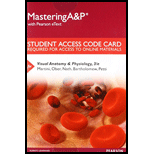
Masteringa&p With Pearson Etext -- Standalone Access Card -- For Fundamentals Of Anatomy & Physiology (11th Edition)
3rd Edition
ISBN: 9780134499710
Author: Martini, Frederic H., Nath, Judi L., Bartholomew, Edwin F.
Publisher: PEARSON
expand_more
expand_more
format_list_bulleted
Concept explainers
Question
Chapter 17, Problem 17CRQ
Summary Introduction
Introduction: Red blood cells (RBCs) make about 99.9% of the whole blood volume. RBCs also are known as erythrocytes and are considered as the most abundant blood cells. RBCs are crucial for the transport of oxygen in the blood.
Expert Solution & Answer
Want to see the full answer?
Check out a sample textbook solution
Students have asked these similar questions
What is the colour of RBCs?
What is leukotrienes? explain at your own words
In the absence of infection, what percentage of cells in human blood are leukocytes?
Chapter 17 Solutions
Masteringa&p With Pearson Etext -- Standalone Access Card -- For Fundamentals Of Anatomy & Physiology (11th Edition)
Ch. 17.1 - Prob. 1RCh. 17.1 - Prob. 2RCh. 17.1 - Prob. 3RCh. 17.1 - Prob. 4RCh. 17.1 - Prob. 5RCh. 17.1 - Prob. 1LOCh. 17.1 - Describe the important components and major...Ch. 17.1 - Prob. 3LOCh. 17.1 - Prob. 1ICh. 17.1 - Prob. 2I
Ch. 17.1 - Prob. 1SRCh. 17.1 - Prob. 2SRCh. 17.1 - Prob. 3SRCh. 17.1 - Prob. 4SRCh. 17.1 - Prob. 5SRCh. 17.1 - Prob. 6SRCh. 17.1 - Prob. 7SRCh. 17.1 - Prob. 8SRCh. 17.1 - Prob. 9SRCh. 17.1 - Prob. 10SRCh. 17.1 - Prob. 11SRCh. 17.1 - Prob. 12SRCh. 17.1 - Prob. 13SRCh. 17.1 - Prob. 14SRCh. 17.1 - Prob. 15SRCh. 17.2 - Prob. 1RCh. 17.2 - Prob. 2RCh. 17.2 - Prob. 3RCh. 17.2 - Prob. 4RCh. 17.2 - Prob. 5RCh. 17.2 - Prob. 6RCh. 17.2 - Prob. 7RCh. 17.2 - Prob. 8RCh. 17.2 - Prob. 9RCh. 17.2 - Prob. 10RCh. 17.2 - Prob. 11RCh. 17.2 - Prob. 12RCh. 17.2 - Prob. 13RCh. 17.2 - Prob. 14RCh. 17.2 - Prob. 15RCh. 17.2 - Prob. 16RCh. 17.2 - Prob. 17RCh. 17.2 - Prob. 1LOCh. 17.2 - Prob. 2LOCh. 17.2 - Prob. 3LOCh. 17.2 - Prob. 4LOCh. 17.2 - Prob. 5LOCh. 17.2 - Prob. 6LOCh. 17.2 - Prob. 7LOCh. 17.2 - Prob. 8LOCh. 17.2 - Prob. 1ICh. 17.2 - Prob. 2ICh. 17.2 - Prob. 3ICh. 17.2 - Prob. 4ICh. 17.2 - Prob. 5ICh. 17.2 - Prob. 1SRCh. 17.2 - Prob. 19SRCh. 17.2 - Prob. 20SRCh. 17.2 - Prob. 21SRCh. 17.2 - Prob. 22SRCh. 17.2 - Prob. 23SRCh. 17.2 - Prob. 24SRCh. 17.2 - Prob. 25SRCh. 17.2 - Prob. 26SRCh. 17.2 - Prob. 27SRCh. 17.2 - Prob. 28SRCh. 17.2 - Prob. 29SRCh. 17.2 - Prob. 30SRCh. 17.2 - Prob. 31SRCh. 17 - Prob. 1CRQCh. 17 - Prob. 2CRQCh. 17 - Prob. 3CRQCh. 17 - Prob. 4CRQCh. 17 - Prob. 5CRQCh. 17 - Prob. 6CRQCh. 17 - Prob. 7CRQCh. 17 - Prob. 8CRQCh. 17 - Prob. 9CRQCh. 17 - Prob. 10CRQCh. 17 - Prob. 11CRQCh. 17 - Prob. 12CRQCh. 17 - Prob. 13CRQCh. 17 - Prob. 14CRQCh. 17 - Prob. 15CRQCh. 17 - Prob. 16CRQCh. 17 - Prob. 17CRQCh. 17 - Prob. 18CRQCh. 17 - Describe the various types of leukemias.
Ch. 17 - Prob. 20CRQCh. 17 - Prob. 21CRQCh. 17 - Prob. 1CICh. 17 - Prob. 2CICh. 17 - Prob. 3CICh. 17 - Prob. 4CICh. 17 - Prob. 5CICh. 17 - Prob. 6CICh. 17 - Prob. 7CI
Knowledge Booster
Learn more about
Need a deep-dive on the concept behind this application? Look no further. Learn more about this topic, biology and related others by exploring similar questions and additional content below.Similar questions
arrow_back_ios
arrow_forward_ios
Recommended textbooks for you
 Human Biology (MindTap Course List)BiologyISBN:9781305112100Author:Cecie Starr, Beverly McMillanPublisher:Cengage Learning
Human Biology (MindTap Course List)BiologyISBN:9781305112100Author:Cecie Starr, Beverly McMillanPublisher:Cengage Learning


Human Biology (MindTap Course List)
Biology
ISBN:9781305112100
Author:Cecie Starr, Beverly McMillan
Publisher:Cengage Learning